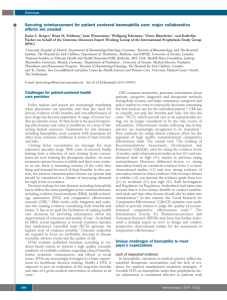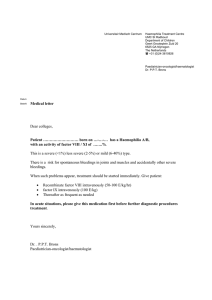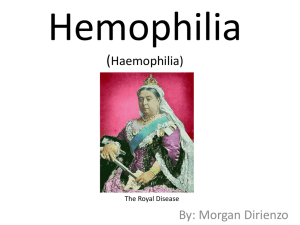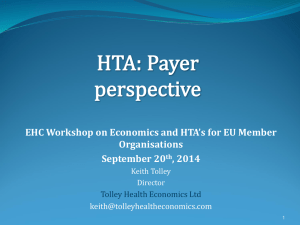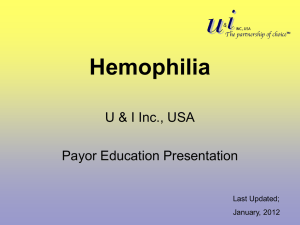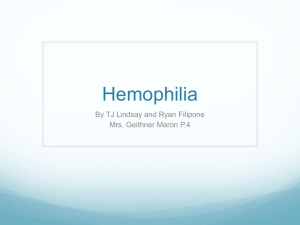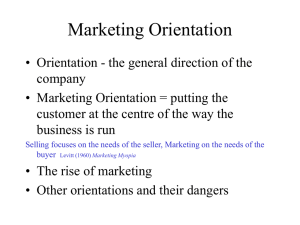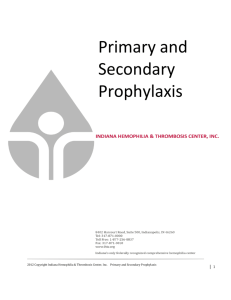Study design - McMaster Hemophilia Research Group
advertisement
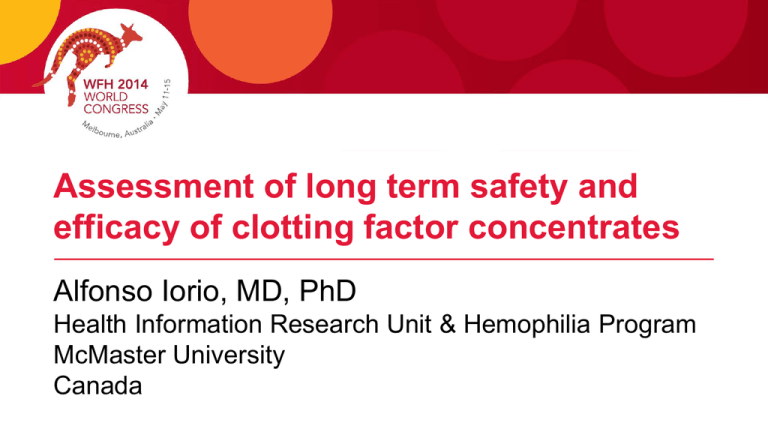
Assessment of long term safety and efficacy of clotting factor concentrates Alfonso Iorio, MD, PhD Health Information Research Unit & Hemophilia Program McMaster University Canada Disclosures for: Alfonso Iorio In compliance with the EACCME* policy, WFH requires the following disclosures be made at each presentation CONFLICT DISCLOSURE — IF CONFLICT OF INTEREST EXISTS RESEARCH SUPPORT Baxter (Bayer, Biogen Idec, NovoNordisk, Pfizer - No conflicts) DIRECTOR, OFFICER, EMPLOYEE CHESS/CHR/CHARMS, WFH Data & Demographics Committee SHAREHOLDER HONORARIA Bayer, Baxter, Biogen Idec, CSL, NovoNordisk, Octapharma, Pfizer – No conflicts ADVISORY COMMITTEE Bayer, Baxter, Biogen Idec, CSL, NovoNordisk, Octapharma, Pfizer – No conflicts CONSULTANT Bayer (NovoNordisk – No conflicts) * European Accreditation Council for Continuing Medical Education Assessment of long term safety and efficacy of clotting factor concentrates • Vision • A few key technical aspects • State of the art • Future perspectives Assessment of long term safety and efficacy of clotting factor concentrates • Vision • Safe, effective, convenient and affordable treatment for as many patients as we can wherever they happen to be born • Technical aspects • State of the art Assessment of efficacy and safety • Setting the stage: ① Efficacy and effectiveness ① Long versus short term ① Absolute versus relative ① Concentrates versus regimens ① Individuals versus populations Haemophilia Product Development HIV screening Low-purity pd concentrates Cryoprecipitate Mid 1960s 1970s High-purity rFIX available concentrates Manufacturing changes Intermediate-purity rFVIII for rFVIII product concentrates available Early 1980s Mid 1980s Late 1980s Early 1990s Late 1990s Early 2000s HCV Viral screening inactivation Viral partitioning Nanofiltration Donor/plasma through heat via chromatography screening for HBV treatment Heat-treated steps concentrates Solvent/ detergent widely available available Adapted with permission from Key NS, et al. 1. Key NS, et al. Lancet. 2007;370:439–448. Late 2000s Today Modified concentrates A more realistic representation.. progress progress effort effort The reality is slightly different.. • Study design • Study setting • Study size • Outcome measure(s) • Comparator(s) Study design • Administrative databases • National health care systems / insurance databases • Disease registry • Dedicated research databases • Prospective targeted research projects • Comprehensiveness • Risk of bias reduction techniques Canadian Hemophilia Assessment Resource Management System (CHARMS) Over 10 years 2260 patients FC units tracked FVIII: 1 009 097 765 FIX: 272 406 859 Traore, A et al. First analysis of 10 years trends in national factor concentrate utilization in Canada. Hemophilia, 2014, accepted The EUHASS study • Strengths • Prospective, very large inception cohort • Controlled (parallel, head-tohead) • Limitations • Minimal information collected • No multivariable approach • Confounding still possible • Dynamic cohort not always at steady-state EUHASS: Inhibitors in PTPs Product Inhibitors Pt/yr Rate (95% C.I.) 1 5 4656 0.11 (0.03-0.25) 2 1 1987 0.05 (0.00 - 0.28) 3 6 3519 0.17 (0.06 - 0.37) 4 3 2338 0.13 (0.03 - 0.37) Data from the EUHASS annual reports to the Investigators Inhibitor rates, selected recombinant FVIII Product Studies Rate (x 100 py) 95% CI Advate 9 0.10 0.05-0.18 Kogenate 9 0.12 (0.04-0.33)* Refacto 8 0.19 0.11-0.34 PD factor VIII 4 0.09 0.02-0.45 * 0.26 (0.16 - 0.44) at fixed effect model Xi, M et al. Journal of Thrombosis and Haemostasis : JTH, 2013; 11(9), 1655–62. Year Inhib Exposed Proportion 2009 8 59 0.31 2010 34 121 0.28 2011 63 221 0.29 2012 96 336 0.29 Data from the EUHASS annual reports to the Investigators EUHASS P EUHASS -RODIN LCI UCI P LCI UCI Plasma D 0.22 0.11 0.35 0.21 0.10 0.37 Recomb 0.26 0.22 0.31 0.24 0.19 0.29 A 0.26 0.19 0.34 0.26 0.17 0.36 B 0.32 0.18 0.50 0.33 0.18 0.52 C 0.30 0.22 0.40 0.22 0.13 0.33 D 0.29 0.17 0.43 0.27 0.15 0.43 Stakeholders and barriers • Manufacturers • Accessibility to data – comparative effectiveness • Patients • “Disease” denial – burden of data generation • Treaters • Time commitment – applied science • Researchers • Small return Patient data meta-analysis of Post Authorization Safety Surveillance (PASS) studies of hemophilia A patients treated with rAHF-PFM Iorio, Marcucci, Cheng, Romanov, Thabane. Hemophilia, submitted. Study Australia-PASS Europe-PASS Japan-PASS Italy-PASS US-PASS Patients (n 1,188) 34 (2.9) 419 (35.3) 361 (30.4) 281 (23.6) 93 (7.8) Patient Characteristics & ABR Characteristics, n (%) >150 previous EDs Num (%) 1016 (85.5) Prophylaxis at enrolment 743 (62.6) ≥ twice/week during the study 587 (49.4) Characteristics, n (%) ABR Num Median (Q1, Q3) 1,140 3.83 (0.60, 12.90) On demand at enrolment 421 10.38 (2.27, 27.29) On prophylaxis (on study, any frequency) 710 2.00 (0, 6.73) On prophylaxis (on study, ≥twice/week) 557 1.66 (0, 4.78) All patients Median dose per infusion of 27 IU/kg (Q1 20, Q3 34). Stakeholders and barriers • Manufacturers • Accessibility to data – comparative effectiveness • Patients • “Disease” denial – burden of data generation • Treaters • Time commitment – applied science • Researchers • Small return Effectiveness outcomes • Cure (as a synonym for normal life) • Healthy functional joints • Bleeding (annualized bleeding rate) – Pain – Working capability – School attendance Ways to higher effectiveness • Improving concentrates • Improving adherence • Reducing cost • Tailoring dose • Simplifying treatment • Investigating social and cultural components Safety outcomes • Inhibitor development • Laboratory variability • Blood borne infections • Unexpected events • Long term toxicity of modified molecules • Drug interactions • “Clots”? Safety outcomes Inhibitor event rate in PTPs – so what? As a result of our systematic review, we identified: •39 de novo inhibitors reported in 19 publications. Individual patient data has been collected for: •29 (74%) inhibitor cases overall •14 (36%) from CRFs completed by study investigators •15 (39%) extracted from patient-level information available in the published reports. Interim results – inhibitor characteristics Characteristic (n = 29) Age at inhibitor diagnosis (years) Peak titre level (BU/ml) Last know titre level (BU/ml) Patient follow-up (mo) Barbara,A. Care until Cure grant competition, CHS Estimate ? ?? ??? ???? Paradigm shift in trial design • Powell, J et al. Thrombosis and Haemostasis, 2012; 108(5), 913–22 • • Valentino, L et al. JTH. 2012; 10(3), 359–67. • • Randomized , controlled , parallel-group trial of routine prophylaxis vs . on-demand treatment with sucrose-formulated recombinant factor VIII in adults with severe hemophilia A (SPINART). Valentino, L et al. Haemophilia. 2014; 20(3), 398–406. • • A randomized comparison of two prophylaxis regimens and a paired comparison of on-demand and prophylaxis treatments in hemophilia A management. Manco-Johnson, MJ et al. JTH, 2013; 11, 1119–1127. • • Efficacy and safety of prophylaxis with once-weekly BAY 79-4980 compared with thrice-weekly rFVIII-FS in haemophilia A patients. A randomised, active-controlled, double-blind study.. Multicentre, randomized, open-label study of on-demand treatment with two prophylaxis regimens of recombinant coagulation factor IX in haemophilia B subjects. Antunes, SV et al. Haemophilia, 2014; 20(1), 65–72. • Randomized comparison of prophylaxis and on-demand regimens with FEIBA NF in the treatment of haemophilia A and B with inhibitors. Long term comparison of different regimens NL Median (IQR) SW, Median (IQR) P Joint bleeds, 5 yr 10 (4 -18) 2.5 (0.-9.3) <.01 Nr joints 2 (1-4) 3 (2-3) .47 HJHS (max144) 9.0 (2.0 – 18.) 4.0 (2.0 – 6.0) <.01 99 (93-100) <.01 Activity (max 100) 93 (81-98) EQ-D5 utility 0,04 (0.81 – 1.00) 1.00 (0.81 – 1.00) .93 Factor cost 851 (647-1048) 1474 (1154-1778) <.01 Lost production 0 (0-0) 0 (0-0) .82 Fischer, K et al. Intermediate-dose versus high-dose prophylaxis for severe hemophilia: comparing outcome and costs since the 1970s. Blood, 2013; 122(7), 1129–36. New study design • Interrupted time series • Ramsay, C. R. et al. Int J Technol Assess Health Care, 2003;19(4), 613–23. • Paired availability design • Baker, S. G. et al. BMC Med Res Method, 2001;1, 9. • Randomized registry trial • Lauer & D’Agostino NEJM 2013;369(17), 1579–81. Prospective urban rural epidemiology (PURE) study Lear, S. A. CMAJ, 2014 186(4), 258–66. Innovation • Bailey, SD. Diabetologia, 2014,57;4:738-45 • Huffman, MD and Yusuf, S. JAMA. 2014,63;14:1368-70 Conclusions • Clear need for surveillance • Clear evidence of progress • Need for harmonization • Need for guidance Thanks hemophilia.mcmaster.ca


